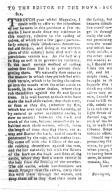[ To the Editor [on Treating Cattle Lice] ]
Date: 1791/03/01
Source:
Nova Scotia Magazine
Institution: Nova Scotia Archives
| Source Origin: Nova Scotia Newspapers on Microfilm
| Reference: Microfilm Reels 8062, 8063
A letter dated 24 February 1791 detailing the causes and dangers of lice in calves followed by two remedies for preventing and eliminating infestations. Vol. 4 (March 1791) nn.143. Microfilm Reel 8063.
TO THE EDITOR OF THE NOVA-SCOTIA MAGAZINE
Sir,
THROUGH your useful Magazine, I
could wish to offer to the inspection
of our farmers in this province a few re-
marks I have made since my residence in
this country, relative to the raising of
calves, of which not a few (more particu-
larly among those inhabitants denomina-
ted old settlers, and living in the western
parts of this colony) have died with that
pernicious vermin lice. As the best way
to stop an evil is to prevent its existence,
so the most certain method of raising
calves free from lice is to prevent their
getting them. We naturally then recur to
the manner in which they get infested with
these vermin, which is by letting the calves
go into the woods with the other cattle to
browse, in the winter season, where they
rub themselves against the fir and spruce
trees. It is well known to those who have
made the least observation, that those trees,
as soon as they die, (whether by fire,
which has over-run the woods formerly, or
by natural or other accidental causes, is
now no matter) between the bark and
trunk of the tree, become immediately in-
habited with those vermin, which, from
the length of time they stay there, eat a-
way and shatter the bark, and of course is
penetrated by the rain, which makes it ea-
sily come off with the friction of the cat-
tle rubbing themselves against the tree,
and the live naturally fall with the shivers
of the bark on the back and sides of the
cattle, where they find a warm retreat in
the hair from the severity of the weather.
The old cattle, whose constitutions are
much stronger than the calves, carry their
lice with them through the winter, and
drop them off as they shed their coats in
___
the spring, but the yearlings immediately
become diseased, more particularly as the
lice crawl towards the head, as they soon
get in through the ears. If this then is
really the case (which from experience in
not permitting my youngest cattle to go
into the woods before they are a year old,
and which have never been troubled with
those insects, except a few they get from
the other cattle when they return out of
the woods) as I am fully of opinion that it
is, I should recommend their being kept at
home the winter before they are a year
old, and let the boughs of birch and
maple trees, with the buds, be cut and
brought to them. But lest many may
suppose this too much trouble, or they
think my observations are futile, and their
calves may get troubled with these ver-
min, I could wish to inform them of a me-
thod to kill them effectually, and without
risk, unless too much be applied -- which
is to rub the ridge along the back with a
light streak of liver (codish) oil, and tie a
flannel rag, with this oil on it, round the
neck of the beast; or a more safe method
is, to wash the back of the creature with
tobacco steeped in water, or lye made of
tobacco ashes.
Should my remarks be of any service in
promoting the growth of cattle in this pro-
vince, by preventing their death with lice,
when young, I shall feel sufficiently pleased
in having been of service to my fellow-far-
mers, in contributing to their wealth, and
remain, Sir,
Your very humble servant,
A NOVA-SCOTIAN.
Barrington, Feb. 24, 1791.
Download: Transcription | Images
